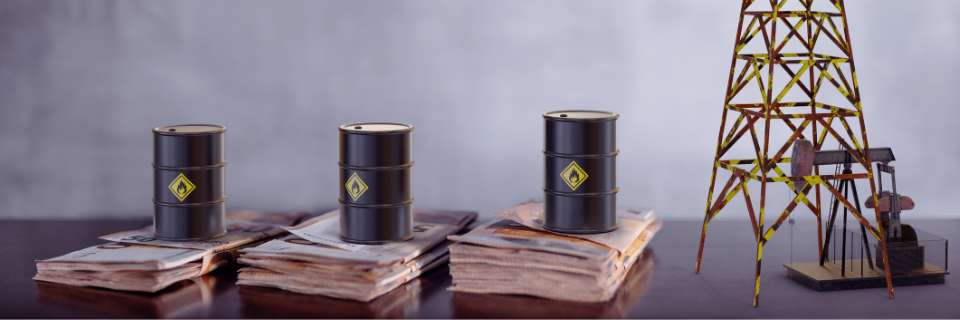The ICE Brent margin is of great interest to many investors, given that ICE Brent futures serve as the primary avenues for investing in or speculating on the world’s most important crude oil benchmark – Brent Crude OOil.
This article will provide detailed information on Brent crude oil futures, including margin requirements, trading hours, and settlement dates. Key takeaways in this article includes:
- Brent futures are divided into Standard Brent Futures (1,000 barrels) and Mini Brent Futures (100 barrels) based on contract specifications.
- The margin requirement for Standard Brent crude oil futures is $5,870, while Mini futures require only $587.
- Brent crude oil futures trading hours are from 08:00 on each day to 06:00 the next day, with trading available for 22 hours per day.
Introduction to Brent Crude Oil Futures
Unlike other major commodity futures such as WTI Futures and Gold Futures, Brent crude oil futures are traded as the flagship commodity on the Intercontinental Exchange (ICE), rather than being listed on the New York Mercantile Exchange (NYMEX).
Brent crude oil futures reflect market expectations for the future delivery price of Brent crude oil. They are a vital component of the Brent crude oil pricing ecosystem and hold significant importance for both oil-producing companies and oil investors:
- Brent futures serve as a crucial hedging tool for oil-producing companies.
- Investors can use Brent crude oil futures for investment or speculation on the price of Brent.
As for this article, we will primarily examine whether Brent futures are suitable for individual investors from the perspectives of investing and speculating in Brent.
Types of Brent Oil Futures
While there is only one Brent crude oil futures for the public, there are two different types for finance traders, the standard Brent futures and the mini Brent futures, with different contract size.
1. Standard Brent Futures
The contract specification for Standard Brent Futures is for 1,000 barrels per contract, and it is a futures commodity traded on the ICE Futures Europe Exchange. With the current price of Brent crude oil at around $90 per barrel, the value of one contract of Standard Brent Crude Oil Futures is $90,000.
With a contract value approaching $100,000, it’s evident that Standard Futures contracts are beyond the means of most individual investors. Therefore, the primary traders of standard futures are oil exploration, refining, and wholesale-related companies.
Their trading objective is typically hedging to manage their exposure to price fluctuations in the oil market.
2. Mini Brent Futures
Mini Brent Futures are introduced by the ICE Futures Singapore exchange with the aim of enhancing trading activity in the Asian market for Brent futures. Its contract specifications are one-tenth of the standard futures, meaning one contract represents 100 barrels.
Mini Brent provides oil companies with more flexible hedging options, and the smaller contract size attracts more asset managers, hedge funds, and individual traders, thus improving market liquidity.
Based on market price of $90 per barrel, one contract of Mini Brent is valued at $9,000, which is still consider not affordable for the average individual.
In the next section, we will examine whether the margin requirement for Mini Brent Crude Oil Futures is within the range acceptable to individual investors from the perspective of trading margins.
Margin Requirement for ICE Brent Futures
The margin requirement for Brent crude oil futures is determined by the ICE exchange and may be adjusted periodically based on market prices and volatility.
Futures brokers typically base their margin requirements on those set by ICE but may set their own requirements. As a result, margin requirements may vary slightly among different futures brokers, but the differences are usually not significant.
1. Standard Brent Margin
At the time of writing this, the standard Brent crude oil front-month contract (June 2024 contract), the margin requirement set by ICE exchange is $5,870. With Brent oil priced at around $90 per barrel, one standard contract is valued at $90,000.
Calculated from this, the margin requirement represents approximately 6.5% of the contract value, or equivalent to leverage of approximately 15 times.
Even with a leverage of 15 times, the $5,870 margin requirement is still a high threshold for ordinary individuals. Additionally, futures brokers typically set both an initial margin and a maintenance margin on top of the $5,870. The initial margin is the margin required when opening a position, while the maintenance margin is the minimum account value that must be maintained after opening a position.
2. Mini Brent Margin
Just like the contract specifications, the margin requirement for Mini Brent crude oil futures is one-tenth of the standard futures, which is $587 per contract. Compared to the requirement of $5,870, the $587 margin reduces the trading threshold to a range that some individual investors may find acceptable. Therefore, individual investors can trade Brent crude oil through Mini Brent futures.
Seeking even lower trading thresholds? Trading Brent through CFDs requires only $1, details can be found in 「UKOIL Trading on MT5: Brent Oil CFD Contract Details」.
Brent Futures Front-Month Contract
In the Brent futures margin section above, we talked about the front month contract of Brent Futures. So, what does it represent? The Brent futures reflect the price expectation of future Brent crude oil, based on the specific day in the future, it is divided into contracts with different expiration dates.
The image above shows, from top to bottom, the quoted data for standard Brent crude oil futures for June, July August and September 2024, with the last column representing volume:
- The further away the contract is from now, the lower the price, indicating a bearish view on future Brent crude oil.
- The closer the contract is to now, the higher the trading volume, making the near-month contract as the main contract for Brent futures, which also known as the “front-month” contract.
The front-month contract is the most actively traded contract among all months’ contracts.
Unless specifically stated otherwise, when discussing Brent crude oil futures contracts, it generally refers to the front-month contract. Whether it’s standard or mini Brent futures, the main contract is the front-month contract, and both have the same expiration settlement date and settlement method.
Brent Crude Futures Settlement Date
1. Brent Futures Expiration Date
Brent crude oil is traded in monthly contracts, with up to 96 consecutive months of contracts listed for trading simultaneously. The nearest contract is the one expiring two months ahead. For example, if the current month is April 2024, the nearest contract would be for June 2024.
The expiration date for all contracts is the last trading day of the month two months prior to the contract month. For instance, the expiration date for the June 2024 contract would be April 30, 2024. The settlement day for Brent crude oil futures is the first business day after the expiration date.
- Expiration Date: The last trading day of the month two months prior to the contract month
- Settlement Date: The first business day after the expiration date
2. Brent Crude Oil Futures Index
Unlike WTI crude oil futures, Brent crude oil futures are designed for cash settlement. On the expiration settlement date, the seller does not need to deliver physical crude oil to the buyer. Instead, they settle the difference between the agreed-upon price and the Brent crude oil futures index price published by ICE Exchange directly in cash.
The Brent Crude Oil Futures Index is a unique concept in Brent trading. It represents the average price of forward contracts for Brent related months as confirmed by industry media. After the expiration of the main contract, ICE publishes the Brent Crude Oil Futures Index as the final cash settlement price for that contract.
Brent Futures Trading Hours
Although it is produced in the North Sea region of the United Kingdom, Brent crude oil play an important role in supplies the global energy market and serves as the most important benchmark for crude oil.
Hence, the trading hours for the Brent futures consider on market participants from around the world, with trading available for 22 hours each day, allowing participants from different time zones to participate in the trading.
Brent Futures Trading Hours (GMT+8):
Trading Hours (US Daylight Saving Time): 08:00 ~ 06:00 next day
Trading Hours (US Standard time): 09:00 ~ 07:00 next day
Brent Futures VS Brent CFD
The Brent Futures require a margin of $5,870 for its standard contract and $587 for the Mini Brent futures contract. By comparing both, it’s clear that the Mini Brent threshold is more affordable for the majority of individual investors.
However, investor that looking to trade the Brent crude oil in fact have an another option beyond the Mini Brent futures, which is the Brent CFDs (Contract for Differences). Brent CFDs are derivate instruments based on Brent crude oil, allowing investors to speculate or invest in the price movements of Brent crude oil without needing to participate directly in the futures or spot market.
Brent CFDs typically supports trading with a minimum of 0.01 lots (1 barrel), offering leverage of up to hundreds of times, and requiring as little as $1 in margin to trade. Click the article below to learn more:






